The 4K Technology Market is estimated to be valued at USD 257.9 billion in 2025 and is projected to reach USD 1596.9 billion by 2035, registering a compound annual growth rate (CAGR) of 20.0% over the forecast period. Early expansion is driven by rising penetration in televisions, monitors, and projectors, supported by falling device costs and enhanced content availability. Mid-period growth accelerates as 4K resolution becomes standard in commercial settings, including advertising displays, streaming services, and corporate installations, while gaming and content creation sectors increasingly demand high-resolution solutions. Later years demonstrate sustained momentum, fueled by widespread replacement of older HD and Full HD systems, integration in advanced imaging devices, and expanding digital infrastructure. Year-on-year growth exhibits a sharp upward curve, with early adoption contributing to moderate gains and later years showing significant expansion as mainstream and professional usage converge.
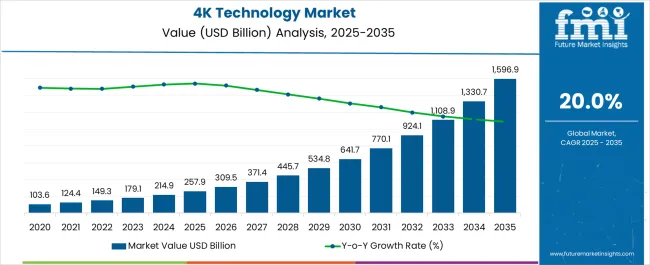
| Metric | Value |
|---|---|
| 4K Technology Market Estimated Value in (2025 E) | USD 257.9 billion |
| 4K Technology Market Forecast Value in (2035 F) | USD 1596.9 billion |
| Forecast CAGR (2025 to 2035) | 20.0% |
The 4K technology market is expanding rapidly due to rising consumer expectations for ultra high definition content, increasing availability of 4K compatible devices, and broader access to high speed internet. Growth is being driven by content streaming platforms, gaming advancements, and digital broadcasting upgrades that demand sharper resolution and immersive visual experiences.
As production costs for 4K displays continue to decrease, manufacturers are accelerating innovation in televisions, monitors, and projection systems. In parallel, support from content creators and studios for native 4K filming is fueling demand from both entertainment and commercial sectors.
Regulatory standards for broadcast quality and an uptick in adoption of 4K surveillance systems further strengthen market momentum. With continued development in hardware and content ecosystems, the outlook for 4K technology remains highly favorable across both developed and emerging regions.
The 4k technology market is segmented by product, end use, and geographic regions. By product, the 4k technology market is divided into Set-top boxes, TV monitors, Digital signage, Smartphones, and Tablets & laptops. In terms of end use, the 4k technology market is classified into Consumer electronics, Media & entertainment, Healthcare, Education, Retail & advertising, and Others. Regionally, the 4k technology industry is classified into North America, Latin America, Western Europe, Eastern Europe, Balkan & Baltic Countries, Russia & Belarus, Central Asia, East Asia, South Asia & Pacific, and the Middle East & Africa.
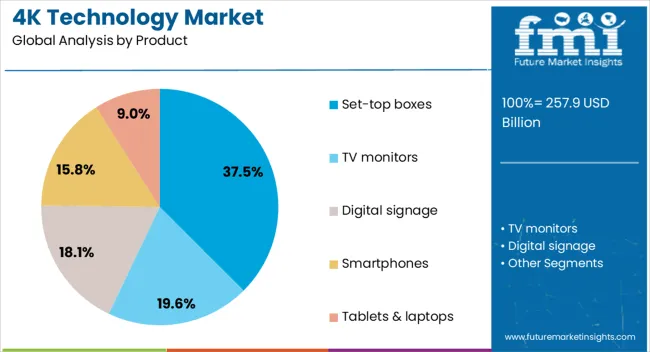
The set top boxes segment is projected to account for 37.50% of total revenue by 2025 within the product category, making it the leading segment. This is primarily due to increased demand for ultra high definition broadcasting, rising adoption of smart televisions, and the transition from standard definition to high resolution viewing.
Service providers are deploying 4K enabled set top boxes to enhance consumer experiences and meet competitive service expectations. These devices also support content streaming, recording, and integration with voice assistance and smart home systems.
With rising availability of 4K content across platforms, the demand for compatible hardware continues to grow. The widespread upgrade of existing television infrastructure and growing consumer appetite for immersive media are reinforcing the dominance of set-top boxes within the 4K product category.
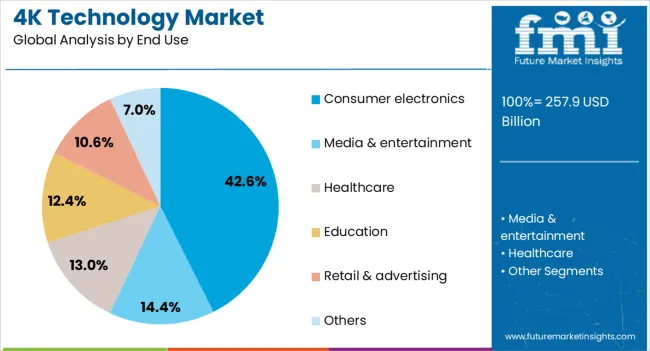
The consumer electronics segment is expected to contribute 42.60% of overall revenue by 2025 under the end use category, maintaining its leadership position. This is supported by increasing consumer spending on premium display technologies, smart devices, and home entertainment systems.
The adoption of 4K in televisions, laptops, tablets, and gaming consoles has surged as manufacturers promote high resolution features as a standard offering. Consumers are prioritizing visual quality, screen size, and HDR support in their purchase decisions, further accelerating 4K penetration.
Retailers and brands are leveraging marketing campaigns centered on superior picture quality and future-ready technology. The alignment of 4K capabilities with lifestyle upgrades and content availability has made consumer electronics the primary driver of growth in the 4K technology market.
The 4K technology market is experiencing rapid growth, driven by the increasing demand for ultra-high-definition content and devices that offer superior picture quality. As consumers continue to seek enhanced viewing experiences, 4K resolution is becoming the new standard in televisions, monitors, and projectors. The rise of streaming platforms and the expansion of content offering 4K resolution have further contributed to the market's growth. Additionally, the adoption of 4K technology in industries such as gaming, entertainment, and healthcare is expanding, further solidifying its place in consumer and professional applications. As technology continues to advance, the market is expected to evolve, offering even more immersive visual experiences.
The growth of the 4K technology market is primarily driven by the increasing demand for high-quality visual experiences. Consumers are increasingly seeking devices that offer clearer, more detailed images, and 4K resolution provides just that with four times the pixel density of traditional HD. The rise of content platforms, such as streaming services like Netflix, Amazon Prime, and YouTube, which offer an increasing amount of 4K content, is driving the adoption of 4K technology in consumer electronics. In the gaming industry, the demand for 4K gaming consoles and PCs is also fueling market growth, as gamers seek higher levels of immersion. Additionally, 4K is becoming the standard in professional sectors such as filmmaking, video production, and healthcare imaging, contributing to the technology's widespread adoption.
Despite the market's growth, the 4K technology market faces challenges related to high costs and limited content availability. The initial cost of 4K devices, including TVs, monitors, and projectors, remains higher than their HD counterparts, which may limit adoption among price-sensitive consumers. While the price of 4K devices is decreasing over time, it still presents a barrier for many potential buyers. Additionally, while 4K content availability is increasing, there is still a limited amount of native 4K content across various platforms and industries. Consumers may not feel the need to upgrade to 4K technology if they cannot access a sufficient amount of 4K content. Overcoming these challenges will require continued reductions in the cost of 4K devices and further investment in content creation and distribution across streaming services and broadcast networks.
The 4K technology market presents significant opportunities in the growth of streaming services and gaming. As more content platforms begin to offer 4K video streaming options, the demand for 4K-enabled devices is expected to rise. Streaming services like Netflix, Disney+, and Apple TV+ are increasingly adopting 4K resolution for their original content and movies, encouraging consumers to upgrade their devices to enjoy these enhanced experiences. The gaming industry also presents a huge opportunity for 4K adoption, as gaming consoles like the PlayStation 5 and Xbox Series X, along with high-end gaming PCs, increasingly support 4K gaming. These devices provide gamers with sharper graphics and better performance, driving the demand for 4K monitors and TVs. As 4K content continues to proliferate in both entertainment and gaming, the market for 4K technology will see continued expansion.
A key trend in the 4K technology market is the gradual transition toward even higher resolutions, such as 8K, as display technologies continue to evolve. While 4K remains the standard for most consumer electronics, 8K TVs and content are beginning to enter the market, offering an even more detailed viewing experience. This trend is driving innovation in the production of 4K content, as broadcasters and streaming services begin to support 8K content for future compatibility. Additionally, advancements in display technologies such as OLED and MicroLED are enhancing the quality of 4K displays, offering deeper contrast ratios, brighter colors, and better energy efficiency. These improvements are helping to maintain the relevance of 4K technology as a dominant force in the visual display market, despite the growing presence of 8K displays. As the technology continues to advance, 4K is expected to remain a key component of high-definition displays in both consumer and professional sectors.
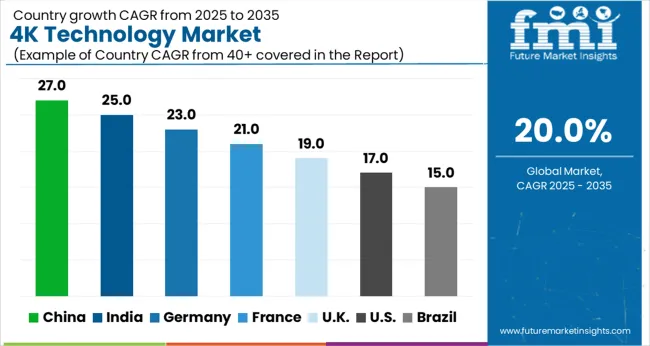
| Countries | CAGR |
|---|---|
| China | 27.0% |
| India | 25.0% |
| Germany | 23.0% |
| France | 21.0% |
| UK. | 19.0% |
| USA | 17.0% |
| Brazil | 15.0% |
The global 4K technology market is projected to grow at a CAGR of 20% from 2025 to 2035. Of the five profiled markets out of 40 covered, China leads at 27.0%, followed by India at 25.0%, and France at 21.0%, while the United Kingdom records 19.0% and the United States posts 17.0%. These rates translate to a growth premium of +35% for China, +25% for India, and +5% for France versus the baseline, while the United States and the United Kingdom show slower growth. Divergence reflects local catalysts: the increasing demand for high-definition video content and smart home devices in China and India, while more mature markets like the United States and the United Kingdom experience slower growth due to established infrastructure and market saturation. The analysis includes over 40+ countries, with the leading markets detailed below.
China’s 4K technology market is growing at a 27.0% CAGR through 2035. China’s rapid adoption of high-definition video content, smart TVs, and consumer electronics is driving significant growth in the 4K technology sector. The growing interest in ultra-high-definition television broadcasts and streaming platforms is contributing to the increased demand for 4K devices. Additionally, the rise of smart homes, gaming consoles, and online content streaming is fueling market expansion. China’s substantial manufacturing capabilities and government support for technology innovation further accelerate the adoption of 4K technology across various industries, including entertainment, media, and electronics.
India’s 4K technology market is projected to grow at a 25.0% CAGR through 2035. As India’s digital transformation accelerates, there is increasing demand for high-definition video content, including 4K streaming services, television broadcasts, and gaming. The rising disposable income and interest in premium home entertainment systems are contributing to the rapid adoption of 4K devices. India’s growing internet penetration, along with the increasing availability of 4K content on streaming platforms like Netflix and Amazon Prime, is fueling the market growth. The government’s initiatives in enhancing broadband connectivity and promoting digital services also support the expansion of the 4K market.
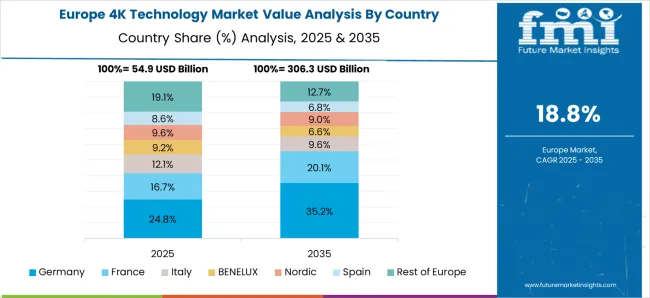
Demand for 4K technology in France is growing at a 21.0% CAGR through 2035. The adoption of 4K devices in France is being driven by the increasing popularity of UHD television broadcasts, content streaming services, and gaming. The country’s strong focus on enhancing digital infrastructure, combined with a growing interest in smart homes and connected devices, is contributing to market growth. The rising demand for high-quality video content and the growing availability of 4K media on streaming platforms are further accelerating the adoption of 4K technology in France. Additionally, France’s role as a key player in the European Union’s digital transformation initiatives supports market expansion.
The UK market for 4K technology is expected to grow at a 19.0% CAGR through 2035. The demand for 4K technology in the UK is being driven by the increasing availability of ultra-high-definition content on television broadcasts and streaming platforms. As consumers seek higher-quality video and audio experiences, the adoption of 4K devices, including TVs and home entertainment systems, is rising. The UK’s growing interest in smart home technologies, combined with the rapid expansion of broadband infrastructure, further supports the market growth. Additionally, the increasing popularity of gaming and the growing demand for immersive experiences drive the adoption of 4K technology.
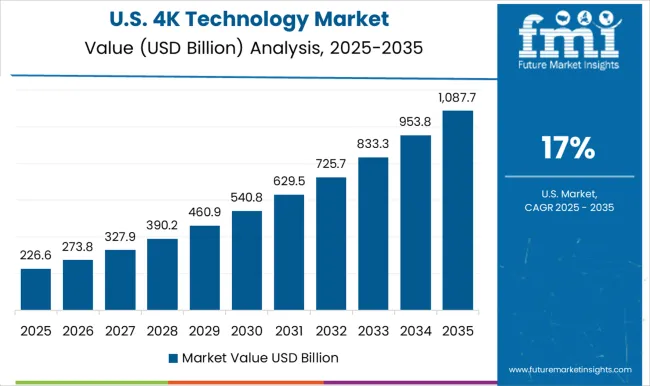
Demand for 4K technology in the USA is projected to grow at a 17.0% CAGR through 2035. The USA is experiencing rapid growth in the adoption of 4K technology, particularly in the entertainment, gaming, and consumer electronics sectors. The rise of 4K content in media, coupled with increasing consumer interest in home theater systems and high-definition video quality, is driving the market forward. Additionally, the expansion of smart TVs, connected devices, and OTT streaming services like Netflix, Hulu, and Amazon Prime contributes to the growing demand for 4K solutions in the USA The increasing use of 4K technology in education, business, and healthcare sectors further supports market growth.
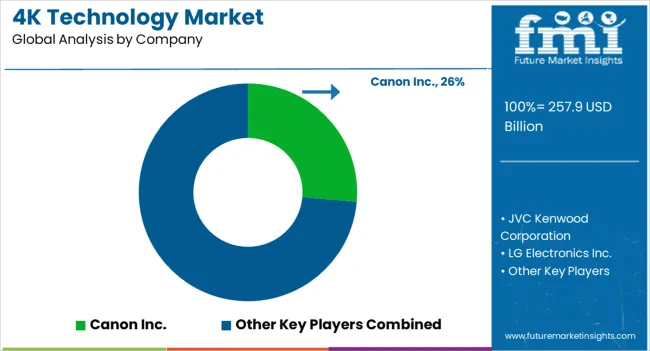
Canon Inc. is a major player in the market, offering 4K cameras and lenses for both professional and consumer applications, with a focus on high-quality imaging and advanced technologies. JVC Kenwood Corporation offers a range of 4K video equipment, catering to both consumer and professional markets, with an emphasis on reliability and performance. LG Electronics Inc. is a key competitor, offering 4K TVs and displays with advanced OLED technology, known for their excellent picture quality, energy efficiency, and smart features. Panasonic Corporation offers 4K imaging solutions, including cameras and displays, with a focus on high-definition resolution, color accuracy, and professional video production applications. Samsung Electronics Co., Ltd. is a dominant player, offering 4K TVs, monitors, and streaming devices, known for their superior screen resolution, brightness, and cutting-edge smart TV functionalities.
Sharp Corporation delivers 4K televisions and display solutions, offering excellent picture quality and energy-efficient products that cater to both consumer and professional markets. Sony Corporation, a major innovator in 4K technology, offers high-quality 4K TVs, cameras, and professional equipment, widely recognized for its image clarity, color reproduction, and advanced video production capabilities.
| Item | Value |
|---|---|
| Quantitative Units | USD 257.9 Billion |
| Product | Set-top boxes, TV monitors, Digital signage, Smartphones, and Tablets & laptops |
| End Use | Consumer electronics, Media & entertainment, Healthcare, Education, Retail & advertising, and Others |
| Regions Covered | North America, Europe, Asia-Pacific, Latin America, Middle East & Africa |
| Country Covered | United States, Canada, Germany, France, United Kingdom, China, Japan, India, Brazil, South Africa |
| Key Companies Profiled | Canon Inc., JVC Kenwood Corporation, LG Electronics Inc., Panasonic Corporation, Samsung Electronics Co., Ltd., Sharp Corporation, and Sony Corporation |
| Additional Attributes | Dollar sales by product type (4K TVs, cameras, projectors, monitors) and end-use segments (consumer electronics, professional video production, gaming, broadcasting). Demand dynamics are driven by the increasing adoption of 4K content, the rise of streaming services, and growing consumer preference for high-definition displays. Regional trends show strong growth in North America, Europe, and Asia-Pacific, with advancements in display technology and rising demand for immersive visual experiences fueling market expansion. |
The global 4k technology market is estimated to be valued at USD 257.9 billion in 2025.
The market size for the 4k technology market is projected to reach USD 1,596.9 billion by 2035.
The 4k technology market is expected to grow at a 20.0% CAGR between 2025 and 2035.
The key product types in 4k technology market are set-top boxes, tv monitors, digital signage, smartphones and tablets & laptops.
In terms of end use, consumer electronics segment to command 42.6% share in the 4k technology market in 2025.






Our Research Products

The "Full Research Suite" delivers actionable market intel, deep dives on markets or technologies, so clients act faster, cut risk, and unlock growth.

The Leaderboard benchmarks and ranks top vendors, classifying them as Established Leaders, Leading Challengers, or Disruptors & Challengers.

Locates where complements amplify value and substitutes erode it, forecasting net impact by horizon

We deliver granular, decision-grade intel: market sizing, 5-year forecasts, pricing, adoption, usage, revenue, and operational KPIs—plus competitor tracking, regulation, and value chains—across 60 countries broadly.

Spot the shifts before they hit your P&L. We track inflection points, adoption curves, pricing moves, and ecosystem plays to show where demand is heading, why it is changing, and what to do next across high-growth markets and disruptive tech

Real-time reads of user behavior. We track shifting priorities, perceptions of today’s and next-gen services, and provider experience, then pace how fast tech moves from trial to adoption, blending buyer, consumer, and channel inputs with social signals (#WhySwitch, #UX).

Partner with our analyst team to build a custom report designed around your business priorities. From analysing market trends to assessing competitors or crafting bespoke datasets, we tailor insights to your needs.
Supplier Intelligence
Discovery & Profiling
Capacity & Footprint
Performance & Risk
Compliance & Governance
Commercial Readiness
Who Supplies Whom
Scorecards & Shortlists
Playbooks & Docs
Category Intelligence
Definition & Scope
Demand & Use Cases
Cost Drivers
Market Structure
Supply Chain Map
Trade & Policy
Operating Norms
Deliverables
Buyer Intelligence
Account Basics
Spend & Scope
Procurement Model
Vendor Requirements
Terms & Policies
Entry Strategy
Pain Points & Triggers
Outputs
Pricing Analysis
Benchmarks
Trends
Should-Cost
Indexation
Landed Cost
Commercial Terms
Deliverables
Brand Analysis
Positioning & Value Prop
Share & Presence
Customer Evidence
Go-to-Market
Digital & Reputation
Compliance & Trust
KPIs & Gaps
Outputs
Full Research Suite comprises of:
Market outlook & trends analysis
Interviews & case studies
Strategic recommendations
Vendor profiles & capabilities analysis
5-year forecasts
8 regions and 60+ country-level data splits
Market segment data splits
12 months of continuous data updates
DELIVERED AS:
PDF EXCEL ONLINE
4K Drawing Tablet with Screen Market Size and Share Forecast Outlook 2025 to 2035
4K VR Displays Market Size and Share Forecast Outlook 2025 to 2035
4K Satellite Broadcasting Market Size and Share Forecast Outlook 2025 to 2035
4K Display Resolution Market Size and Share Forecast Outlook 2025 to 2035
5G technology market Analysis by Technology Type, Application, Vertical, and Region – Growth, trends and forecast from 2025 to 2035
8K Technology Market
Nanotechnology Photocatalysis Surface Coating Industry Analysis in AMEA Size and Share Forecast Outlook 2025 to 2035
Nanotechnology Packaging Market Size and Share Forecast Outlook 2025 to 2035
Key Players & Market Share in GDS Technology Market
GDS Technology Market Insights - Growth & Forecast 2025 to 2035
Nanotechnology for food packaging Market
Food Technology Market Size and Share Forecast Outlook 2025 to 2035
Smart-Technology Anti-Wrinkle Peptides Market Size and Share Forecast Outlook 2025 to 2035
Laser Technology Market Size and Share Forecast Outlook 2025 to 2035
Green Technology And Sustainability Market Size and Share Forecast Outlook 2025 to 2035
Camera Technology Market Analysis – Trends & Forecast 2025 to 2035
Battery Technology Market Size and Share Forecast Outlook 2025 to 2035
Airline Technology Integration Market Size and Share Forecast Outlook 2025 to 2035
Food Biotechnology Market Size and Share Forecast Outlook 2025 to 2035
IO-Link technology Market Size and Share Forecast Outlook 2025 to 2035

Thank you!
You will receive an email from our Business Development Manager. Please be sure to check your SPAM/JUNK folder too.
Chat With
MaRIA